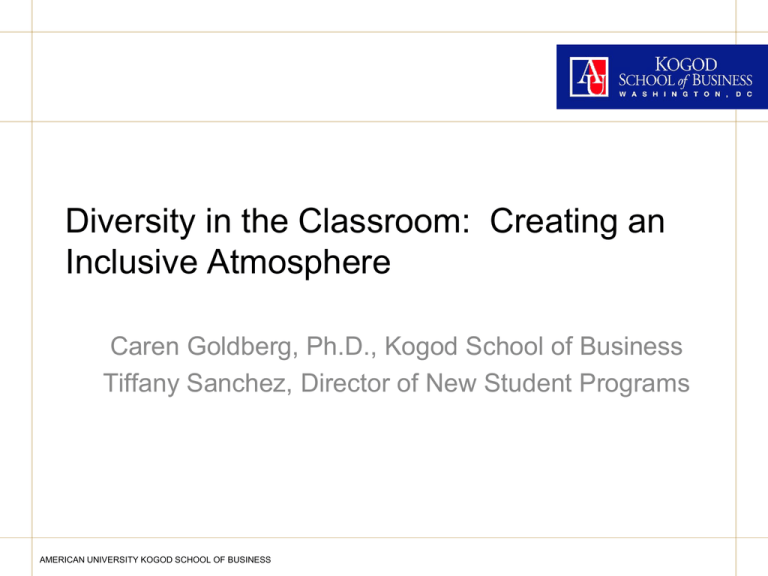Diversity in the Classroom: Creating an Inclusive Atmosphere
advertisement

Diversity in the Classroom: Creating an Inclusive Atmosphere Caren Goldberg, Ph.D., Kogod School of Business Tiffany Sanchez, Director of New Student Programs AMERICAN UNIVERSITY KOGOD SCHOOL OF BUSINESS How Inclusive is the Environment at AU? • The CIRP (Cooperative Institutional Research Program) Freshman Survey is administered by the HERI at UCLA in the beginning of the fall. They have collected data from students at over 1,900 institutions in the US. • Your First College Year, has been developed by HERI and the Policy Center on the First Year of College at Brevard College. It measures many of the same items as CIRP, at the end of the spring. • Combining these two provides a comparison of how expectations match reality. AMERICAN UNIVERSITY KOGOD SCHOOL OF BUSINESS Expectations vs. Reality: % Reporting Often/Very Often 80 70 60 50 40 Fall 2007 Spring 2008 30 20 10 0 Socialize Dined/Shared a Meal AMERICAN UNIVERSITY KOGOD SCHOOL OF BUSINESS Had Intellectual Discussions Outside Class Studied/Prepared for Class Attended Events Sponsored by Other Groups General Discrimination: % Somewhat or Strongly Agree 20 18 16 14 12 10 8 6 4 2 0 Race/Ethnicity SES Gender Religion I have felt discriminated against based on my: AMERICAN UNIVERSITY KOGOD SCHOOL OF BUSINESS Sexual Orient Stereotypes in the Classroom 30 25 20 15 10 5 0 Race/Ethnicity Women In class, I have heard faculty express stereotypes about: AMERICAN UNIVERSITY KOGOD SCHOOL OF BUSINESS Men More on Stereotypes… People naturally gravitate towards similar others, but doing so, may increase reliance on stereotypes, because stereotypes are used more heavily when: • Individuals from certain groups (e.g., race, gender, age) are in a clear minority • Individuals have had little experience with others from a particular group • Faculty may permit it through action or inaction AMERICAN UNIVERSITY KOGOD SCHOOL OF BUSINESS Increasing Inclusiveness in the Classroom (1) • Consider assigning students to groups, to avoid the tendency for similar students to gravitate toward one another. • Make a point to learn more about cultures, learning styles, disabilities, etc., with which you are unfamiliar. • Openly discuss average group differences where it is relevant to the class, but articulate the dangers in making assumptions based on these differences. Women are less assertive than men, on average, but does that imply that I am unassertive? AMERICAN UNIVERSITY KOGOD SCHOOL OF BUSINESS Increasing Inclusiveness in the Classroom (2) • Be sensitive to the unintended messages students may perceive from you or other students in day-to-day conversations. e.g., “businessmen” • Be careful about going overboard in your attempt to be sensitive to individual students. You might end up creating unintended inequities. AMERICAN UNIVERSITY KOGOD SCHOOL OF BUSINESS Exercise Being Black today in America is like… AMERICAN UNIVERSITY KOGOD SCHOOL OF BUSINESS Moving Beyond Demographics Disabilities -How to accommodate what we can’t see Cultural Differences -Expectations about participation, cheating, etc. Learning Styles -Visual vs. auditory -We tend to teach using styles that are most conducive to our own learning Exam Styles -Essay vs. m/c AMERICAN UNIVERSITY KOGOD SCHOOL OF BUSINESS Example Scenario 1 A student claims to have a disability, but given his obvious fitness, you suspect he is trying to pull one over on you. The student senses your doubt and requests a meeting with you to discuss the nature of his disability. AMERICAN UNIVERSITY KOGOD SCHOOL OF BUSINESS Example Scenario 2 A student clearly “lifted” an entire page of her essay from a published source. When you confront her, the student claims that because you never explicitly said that plagiarism is a form of cheating, she thought it was okay. AMERICAN UNIVERSITY KOGOD SCHOOL OF BUSINESS Example Scenario 3 Although the syllabus clearly states that participation is weighted heavily, you notice a clear division between the extent to which domestic vs. international students participate. Some of your international students have commented that the heavy participation requirement is insensitive to their cultural background. AMERICAN UNIVERSITY KOGOD SCHOOL OF BUSINESS Example Scenario 4 After receiving his/her final grade for the semester, a student comes to your office on the verge of tears. He says that he bombed the final because his learning disability makes taking m/c exams in a classroom with other students very difficult. The student goes on to say that getting the grade you gave means that he will no longer be eligible for his scholarship, which, because of his financial situation, means that he can no longer attend AU. AMERICAN UNIVERSITY KOGOD SCHOOL OF BUSINESS Web Resources on Diversity & Inclusiveness in the Classroom • CIRP - “40 Years of Changes in the Student Body” • http://www.insidehighered.com/news/2007/04/09/cirp • Princeton – Links to Many Classroom D & I Resources • http://www.princeton.edu/~djbutler/ditclink.htm • Bond University’s Website • http://www.bond.edu.au/tls/resources/beyondawareness/conte xt.html# • Kolb's Learning Style Inventory • http://www.haygroup.com/tl/Questionnaires_Workbooks/Kolb_ Learning_Style_Inventory.aspx • Visual vs. Auditory Learning – Auditory Tic-Tac-Toe • http://www.thiagi.com/pfp/IE4H/march2004.html#CognitiveSim ulation AMERICAN UNIVERSITY KOGOD SCHOOL OF BUSINESS

